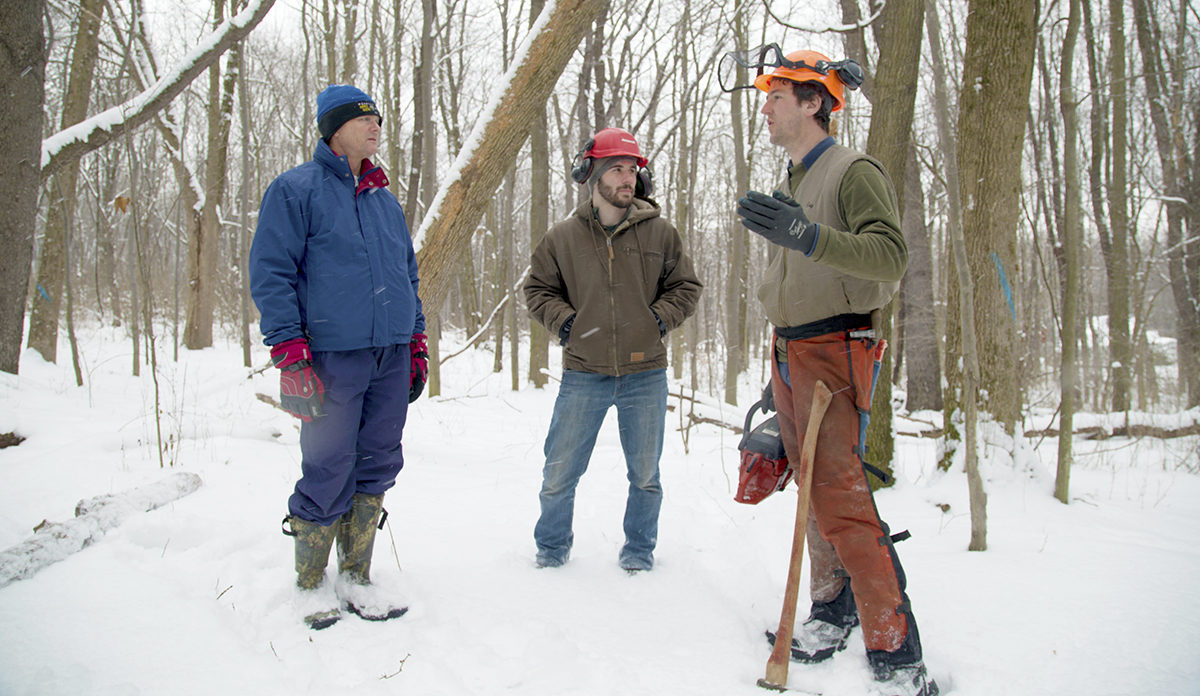
‘Timber!’ resounds around Robertson Complex
As you walk or drive past the area around the Robertson Athletic Complex on these winter days, you might hear the call of “Timber!” echoing through the crisp air. Or you might be able to watch several impressively big brown horses dragging some substantial-looking logs across the snow-strewn fields. You also might hear inquisitive students asking Amish loggers about how they do their jobs.
There’s an ongoing logging operation near the Robertson Complex that is removing diseased, damaged and weak trees. The project, using horse-drawn logging teams, is promoting the growth of ecologically and economically valuable trees and teaching students a lesson in sustainability. Some of the trees are destined for the Louisville Slugger plant where they will be turned into baseball bats. Work started last summer and should wrap up by spring on the 135 acres of forested land owned by the college.
Guy Dunkle ’05 is the chief forester for the project. He agreed to discuss briefly the type of forestry methods being employed and how tree removal will improve the long-term environmental value of this forest, located near the Gators football, baseball and softball fields.
Can you describe what is being done?
The forest management work at Robertson has involved two initial projects. The first was controlling invasive plants that have become widespread in the forest and were detrimental to native plants and animals. This involved students and my employees cutting and killing plants across a wide area. The second project, which is more visible, has been the timber harvest during which Amish horse loggers have removed trees. It is my hope that this will be an ongoing process, with future projects that may include additional invasive plant control and forest regeneration harvests to bring on new, young age classes of trees.
Why is the college doing this?
The purpose of the harvest, termed a “worst first” cut, was to remove trees declining in health, trees facing invasive pests, such as ash which is succumbing to emerald ash borer insects and beech which is dying from beech bark disease, and those with minimal long-term potential. Our goal is for Robertson forest to have a more diverse species composition, a more diverse tree age structure – young, old and middle-age trees throughout – and a wide variety of habitat types. This was not a project centered on commodity production, but rather a project designed to enhance the forest ecosystem, the logs being a useable byproduct.
What is the ecological benefit of restorative logging?
Certainly forest preservation is a crucial component of responsible land stewardship. However, a more difficult challenge for forest stewards is to improve the land through use. A steward must embrace opportunities for positive impact forestry. We all benefit from the clean air and clean water produced by forests. As in agriculture, there is a need to connect the consumers of forest products with the ecosystems and people producing them. The ultimate conservation approach is a system that advances the health of the forest and provides the goods needed to sustain the human community.
What is the educational value of this project?
In my opinion, what makes this project so wonderful is the opportunity to showcase a “multiple-use” forest. It has been so wonderful to talk with students, neighborhood dog walkers, college groundskeepers, and curious passers-by, about the characteristics of a sustainable forest. In the form of clean air, clean water, paper and wood, we use forests every day. Allegheny has taken the important next step of ensuring that Robertson forest is used well. Academically, forestry projects dovetail well with a liberal arts education, helping students think about the relationships between humans, their communities and the natural world. Students played a large role in this project, from the hands on work of cutting invasive plants to the more academic aspect of preparing a plan for future forestry projects.
Why use horse power instead of heavy-duty logging machinery?
Skidding logs with horses offers several distinct advantages over traditional machinery. The comparatively light weight of horses helps avoid much of the soil compaction, rutting and surface disturbance commonly associated with logging. Because a team of horses is narrower and shorter than logging machines, they are able to move through the forest without rubbing against or driving over trees and plants, thereby leaving a healthier residual forest. We also timed our harvest so that skidding would take place when the soil was either dry or frozen and least susceptible to damage.
Tell us about your land trust.
The Foundation for Sustainable Forests is a nonprofit land trust from nearby Spartansburg, Pa. The foundation is dedicated to the permanent protection of working forests in the region. Forest land has been donated to the Foundation and we manage it as an example of best practices in sustainable forestry. We also work with private landowners to help them with sustainable management of their land. The foundation has partnered with Allegheny on the Shared Giving Program wherein forest landowners can make a gift of land that serves as an endowment to both organizations.
Photo Caption: Professor Rich Bowden, left, Guy Dunkle ’05, and Owen Ludwig ’17 discuss the logging operations in January. Photo Credit: Derek Li